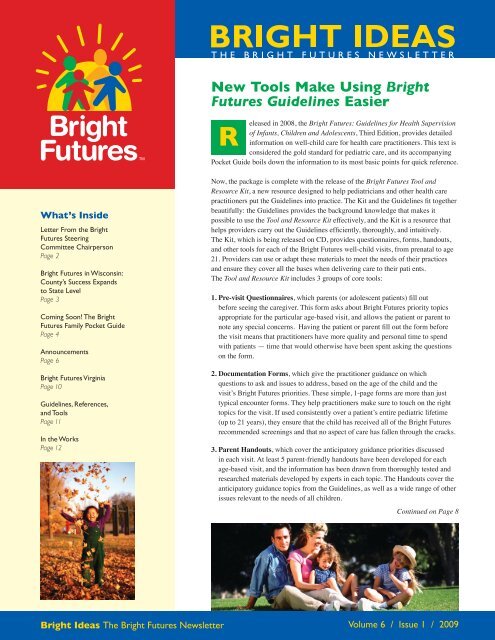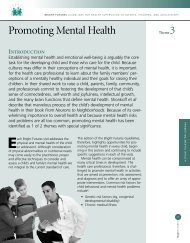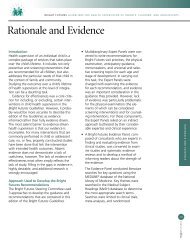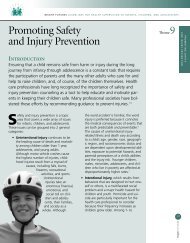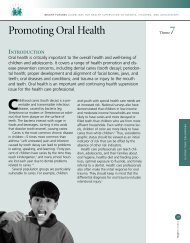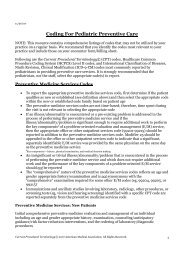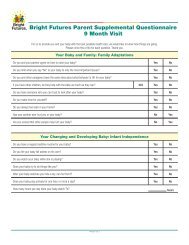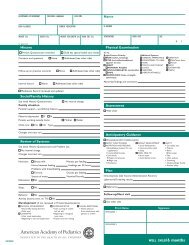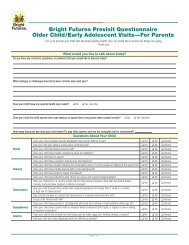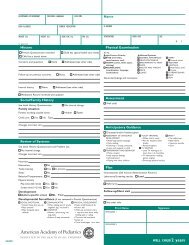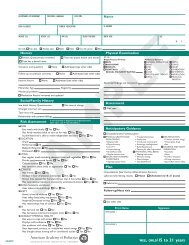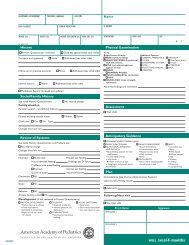New Tools Make Using Bright Futures Guidelines Easier
New Tools Make Using Bright Futures Guidelines Easier
New Tools Make Using Bright Futures Guidelines Easier
You also want an ePaper? Increase the reach of your titles
YUMPU automatically turns print PDFs into web optimized ePapers that Google loves.
What’s Inside<br />
Letter From the <strong>Bright</strong><br />
<strong>Futures</strong> Steering<br />
Committee Chairperson<br />
Page 2<br />
<strong>Bright</strong> <strong>Futures</strong> in Wisconsin:<br />
County’s Success Expands<br />
to State Level<br />
Page 3<br />
Coming Soon! The <strong>Bright</strong><br />
<strong>Futures</strong> Family Pocket Guide<br />
Page 4<br />
Announcements<br />
Page 6<br />
<strong>Bright</strong> <strong>Futures</strong> Virginia<br />
Page 10<br />
<strong>Guidelines</strong>, References,<br />
and <strong>Tools</strong><br />
Page 11<br />
In the Works<br />
Page 12<br />
<strong>Bright</strong> Ideas The <strong>Bright</strong> <strong>Futures</strong> <strong>New</strong>sletter<br />
TM<br />
<strong>New</strong> <strong>Tools</strong> <strong>Make</strong> <strong>Using</strong> <strong>Bright</strong><br />
<strong>Futures</strong> <strong>Guidelines</strong> <strong>Easier</strong><br />
R<br />
eleased in 2008, the <strong>Bright</strong> <strong>Futures</strong>: <strong>Guidelines</strong> for Health Supervision<br />
of Infants, Children and Adolescents, Third Edition, provides detailed<br />
information on well-child care for health care practitioners. This text is<br />
considered the gold standard for pediatric care, and its accompanying<br />
Pocket Guide boils down the information to its most basic points for quick reference.<br />
Now, the package is complete with the release of the <strong>Bright</strong> <strong>Futures</strong> Tool and<br />
Resource Kit, a new resource designed to help pediatricians and other health care<br />
practitioners put the <strong>Guidelines</strong> into practice. The Kit and the <strong>Guidelines</strong> fit together<br />
beautifully: the <strong>Guidelines</strong> provides the background knowledge that makes it<br />
possible to use the Tool and Resource Kit effectively, and the Kit is a resource that<br />
helps providers carry out the <strong>Guidelines</strong> efficiently, thoroughly, and intuitively.<br />
The Kit, which is being released on CD, provides questionnaires, forms, handouts,<br />
and other tools for each of the <strong>Bright</strong> <strong>Futures</strong> well-child visits, from prenatal to age<br />
21. Providers can use or adapt these materials to meet the needs of their practices<br />
and ensure they cover all the bases when delivering care to their pati ents.<br />
The Tool and Resource Kit includes 3 groups of core tools:<br />
1. Pre-visit Questionnaires, which parents (or adolescent patients) fill out<br />
before seeing the caregiver. This form asks about <strong>Bright</strong> <strong>Futures</strong> priority topics<br />
appropriate for the particular age-based visit, and allows the patient or parent to<br />
note any special concerns. Having the patient or parent fill out the form before<br />
the visit means that practitioners have more quality and personal time to spend<br />
with patients — time that would otherwise have been spent asking the questions<br />
on the form.<br />
2. Documentation Forms, which give the practitioner guidance on which<br />
questions to ask and issues to address, based on the age of the child and the<br />
visit’s <strong>Bright</strong> <strong>Futures</strong> priorities. These simple, 1-page forms are more than just<br />
typical encounter forms. They help practitioners make sure to touch on the right<br />
topics for the visit. If used consistently over a patient’s entire pediatric lifetime<br />
(up to 21 years), they ensure that the child has received all of the <strong>Bright</strong> <strong>Futures</strong><br />
recommended screenings and that no aspect of care has fallen through the cracks.<br />
3. Parent Handouts, which cover the anticipatory guidance priorities discussed<br />
in each visit. At least 5 parent-friendly handouts have been developed for each<br />
age-based visit, and the information has been drawn from thoroughly tested and<br />
researched materials developed by experts in each topic. The Handouts cover the<br />
anticipatory guidance topics from the <strong>Guidelines</strong>, as well as a wide range of other<br />
issues relevant to the needs of all children.<br />
Continued on Page 8<br />
Volume 6 / Issue 1 / 2009
The American Academy of Pediatrics (AAP) offers <strong>Bright</strong><br />
Ideas, the <strong>Bright</strong> <strong>Futures</strong> newsletter, to health professionals,<br />
public and private partners with key health constituencies,<br />
and communities and families interested in promoting and<br />
improving the health, education, and well-being of infants,<br />
children, and adolescents. The newsletter is intended as a<br />
forum for sharing information about <strong>Bright</strong> <strong>Futures</strong> and health<br />
promotion and preventive service strategies. <strong>Bright</strong> Ideas is<br />
funded through cooperative agreement (#U04 MC 07853)<br />
from the US Department of Health and Human Services,<br />
Health Resources and Services Administration, Maternal and<br />
Child Health Bureau, to the AAP.<br />
<strong>Bright</strong> <strong>Futures</strong> Steering Committee<br />
Paula M. Duncan, MD, FAAP, Chairperson, <strong>Bright</strong> <strong>Futures</strong>:<br />
Steering Committee<br />
Betsy Anderson, Federation for Children with Special Needs,<br />
Family Voices<br />
Mary Margaret Gottesman, PhD, RN, CPNP, National<br />
Association of Pediatric Nurse Practitioners<br />
Joseph F. Hagan, Jr, MD, FAAP<br />
Judith S. Shaw, EdD, MPH, RN, American Pediatrics Association,<br />
Mary Story, PhD, RD, American Dietetic Association<br />
Jack Swanson, MD, FAAP<br />
Eric M. Wall, MD, MPH, American Academy of<br />
Family Physicians<br />
Federal Liaison<br />
Christopher DeGraw, MD, MPH, FAAP, Maternal and Child<br />
Health Bureau, Health Resources and Services Administration<br />
AAP Staff<br />
V. Fan Tait, MD, FAAP, Principal Investigator,<br />
<strong>Bright</strong> <strong>Futures</strong> Education Center and Pediatric<br />
Implementation Project<br />
Edward Zimmerman, MS, Coprincipal Investigator,<br />
<strong>Bright</strong> <strong>Futures</strong> Education Center<br />
Darcy Steinberg-Hastings, MPH, Director and Coprincipal<br />
Investigator, <strong>Bright</strong> <strong>Futures</strong> Education Center and Pediatric<br />
Implementation Project<br />
Jane Bassewitz, MA, Manager, <strong>Bright</strong> <strong>Futures</strong>, Education Center<br />
Amy Pirretti, MS, Manager, <strong>Bright</strong> <strong>Futures</strong> Materials<br />
Development and Promotion<br />
Maryjo Reynolds, Product Manager, <strong>Bright</strong> <strong>Futures</strong><br />
Sandy Szott, Program Assistant, <strong>Bright</strong> <strong>Futures</strong> Education<br />
Center<br />
Effie Tonkovic, Program Assistant, <strong>Bright</strong> <strong>Futures</strong> Education<br />
Center<br />
Copyright © 2009 American Academy of Pediatrics<br />
Any part of this newsletter may be reproduced for<br />
noncommercial educational purposes.<br />
The recommendations contained in this newsletter and in<br />
the mentioned publications do not indicate an exclusive<br />
course of treatment or serve as a standard of medical care.<br />
Variations, taking into account individual circumstances, may<br />
be appropriate. This newsletter discusses titles published by<br />
organizations other than the American Academy of Pediatrics.<br />
Statements and opinions expressed in these publications<br />
are those of the authors and not necessarily those of the<br />
American Academy of Pediatrics.<br />
Letter from the <strong>Bright</strong> <strong>Futures</strong> Steering<br />
Committee Chairperson<br />
W<br />
e are delighted to bring you this update on our activities since the<br />
last newsletter.<br />
Most importantly, we have completed another piece in the <strong>Bright</strong> <strong>Futures</strong> family of<br />
materials. First came the <strong>Guidelines</strong> themselves and its accompanying <strong>Bright</strong> <strong>Futures</strong><br />
Family Pocket Guide. Now, I’m pleased to announce the release of the <strong>Bright</strong> <strong>Futures</strong> Tool<br />
and Resource Kit. This Kit provides essential materials that will help practitioners carry<br />
out the <strong>Guidelines</strong> efficiently and effectively. The Kit contains pre-visit questionnaires,<br />
documentation forms, patient/parent handouts, practice management tools, and screening<br />
and assessment tools. Read all about the Kit in the feature article on page 1. We couldn’t<br />
have put this valuable resource together without the help and expertise of the many child<br />
health professionals who developed and reviewed all the materials. My sincere gratitude<br />
and thanks go to all of you.<br />
Several states and communities are putting <strong>Bright</strong> <strong>Futures</strong> into practice in innovative ways,<br />
and this issue of the newsletter highlights these activities in Virginia and Dodge County,<br />
Wisconsin. Also featured in this issue is a story about the <strong>Bright</strong> <strong>Futures</strong> Family Pocket<br />
Guide, developed by Family Voices as a way to translate highlights of the <strong>Bright</strong> <strong>Futures</strong><br />
<strong>Guidelines</strong> into a “family-friendly” resource for parents and other caregivers. Several other<br />
exciting new publications are also described in this newsletter, including Building Your<br />
Medical Home Toolkit, <strong>Tools</strong> for Working with Practices to Improve Preventive Care <strong>Using</strong><br />
<strong>Bright</strong> <strong>Futures</strong>, <strong>Bright</strong> <strong>Futures</strong> in Practice: Nutrition, and Coding for Pediatric Preventive<br />
Care 2010.<br />
I’m also happy to announce that the <strong>Bright</strong> <strong>Futures</strong> Activity Book has won a silver National<br />
Health Information Award from the Health Information Resource Center. Congratulations to<br />
those who developed this wonderful resource for parents and children!<br />
Young investigators are being encouraged to conduct research on the effectiveness of health<br />
supervision in primary care through the Academic Pediatric Association <strong>Bright</strong> <strong>Futures</strong><br />
Young Investigators Awards Program. Details of the program are described on page 7, and<br />
the deadline for applications is October 25, 2009.<br />
Looking to the future, our work will continue to promote <strong>Bright</strong> <strong>Futures</strong> activities at the<br />
national, state, and local levels through workshops, presentations, and joint projects. We are<br />
developing a quality improvement project addressing oral health risk assessment in primary<br />
care practice. A second quality improvement project, the <strong>Bright</strong> <strong>Futures</strong> EQIPP module,<br />
will allow clinicians and their medical home teams to measurably improve their delivery of<br />
preventive services. We’ll provide more details as these projects unfold.<br />
We also want to know how you use the <strong>Guidelines</strong> and the new <strong>Bright</strong> <strong>Futures</strong> Tool and<br />
Resource Kit. Do these <strong>Guidelines</strong>, tools, and resources make your work easier? Have<br />
you come up with a creative way to promote the <strong>Bright</strong> <strong>Futures</strong> messages? Have you<br />
incorporated the <strong>Guidelines</strong> and tools into your workplace? Submit your stories at the<br />
<strong>Bright</strong> <strong>Futures</strong> Web site, brightfutures.aap.org, or via e-mail at brightfutures@aap.org. We<br />
will feature some of the stories in future publications and possibly on our Web site so others<br />
can benefit from your experiences.<br />
With warmest regards,<br />
Paula M. Duncan, MD, FAAP<br />
Chairperson, <strong>Bright</strong> <strong>Futures</strong> Steering Committee
<strong>Bright</strong> <strong>Futures</strong> in Wisconsin: County’s Success<br />
Expands to State Level<br />
I<br />
n the past year, public health<br />
professionals in Dodge County,<br />
Wisconsin have worked closely with<br />
the American Academy of Pediatrics<br />
(AAP) to implement <strong>Bright</strong> <strong>Futures</strong> in their local<br />
county health system. This effort was set into motion<br />
by Gretchen Klug, RN, a public health nurse in<br />
Dodge County who was looking for an innovative<br />
way to organize and promote maternal–child health<br />
programs in her county, as well as provide a consistent<br />
framework for prevention activities that could be<br />
easily communicated to other health care practitioners.<br />
Ms. Klug was looking for a strong, credible standard<br />
of care that local public health nurses could use to<br />
support the preventive care available to children and<br />
families in their county. She was impressed by both<br />
the approach of <strong>Bright</strong> <strong>Futures</strong> and the materials<br />
available, and contacted the AAP for guidance in<br />
implementing <strong>Bright</strong> <strong>Futures</strong> in Dodge County.<br />
“This is what public health already does. <strong>Bright</strong><br />
<strong>Futures</strong> provides us a framework, puts it into the<br />
context of what is important, and validates what public<br />
health departments have been doing for a long time”<br />
Ms. Klug said.<br />
<strong>Bright</strong> <strong>Futures</strong> staff began working with Ms. Klug<br />
and Southern Regional office staff for the Wisconsin<br />
Department of Health Services, to develop a regional<br />
<strong>Bright</strong> <strong>Futures</strong> training, which was conducted in June<br />
2008. More recently, a full-day <strong>Bright</strong> <strong>Futures</strong> training<br />
was presented at a statewide public health nursing preconference<br />
in Wisconsin.<br />
These trainings provided participants with an<br />
overview of the <strong>Bright</strong> <strong>Futures</strong> approach to preventive<br />
health care. Participants came out of the training with<br />
an understanding that effective health promotion and<br />
disease prevention require the coordinated efforts<br />
of both medical and non-medical professionals and<br />
agencies. And they saw the special role that public<br />
health nurses have in providing this coordinated<br />
preventive care.<br />
Although <strong>Bright</strong> <strong>Futures</strong> only has been in place in<br />
Dodge County for little more than a year, positive<br />
outcomes already have been observed from its<br />
implementation, including:<br />
Participants have embraced the <strong>Bright</strong> <strong>Futures</strong><br />
approach to preventive care<br />
<strong>Bright</strong> <strong>Futures</strong> health promotion themes are evident<br />
in their daily work with families<br />
Physicians and other health care practitioners are<br />
more aware of the services that the county’s public<br />
health nurses can and do provide<br />
Although any new program faces hurdles, Ms. Klug<br />
said that <strong>Bright</strong> <strong>Futures</strong> has been very well received<br />
in Dodge County. “The AAP gives us credibility and<br />
reliability. We have been focusing on the 10 health<br />
promotion themes in <strong>Bright</strong> <strong>Futures</strong> for a long time<br />
and now the AAP has tied it all together for us.”<br />
<strong>Bright</strong> <strong>Futures</strong> now has been implemented in Dodge<br />
County because Ms. Klug took the initiative to seek<br />
out tools that support public health programs that<br />
focus on preventive care in her county. And now the<br />
<strong>Bright</strong> <strong>Futures</strong> effort has grown beyond the local level<br />
championed at the Wisconsin Department of Health<br />
Services by Murray Katcher, MD, the state’s Chief<br />
Medical Officer for Community Health Promotion and<br />
Ann Stueck, a public health nursing consultant.<br />
The next step in Wisconsin is a series of live Webcasts<br />
jointly sponsored by the AAP and the state Department<br />
of Health Services, Division of Public Health, Family<br />
Health Section. These Webcasts will focus on the<br />
needs of public health nurses and each will feature a<br />
specific <strong>Bright</strong> <strong>Futures</strong> theme. Currently the following<br />
dates and topics have been scheduled:<br />
January 21, 2010 — <strong>Bright</strong> <strong>Futures</strong> on Promoting<br />
Oral Health<br />
March 11, 2010 — <strong>Bright</strong> <strong>Futures</strong> on Promoting<br />
Healthy Weight<br />
May 27, 2010 — <strong>Bright</strong> <strong>Futures</strong> on Promoting<br />
Healthy Nutrition<br />
Additional information on these Web casts will<br />
be available at http://dhs.wisconsin.gov/phnc/<br />
LinksToWebcasts/index.htm. ■<br />
Volume 6 / Issue 1 / 2009 brightfutures.aap.org<br />
3
Coming Soon!<br />
The <strong>Bright</strong> <strong>Futures</strong> Family Pocket Guide<br />
I<br />
n the same way that <strong>Bright</strong> <strong>Futures</strong>:<br />
<strong>Guidelines</strong> for Health Supervision of<br />
Infants, Children, and Adolescents, Third<br />
Edition informs pediatricians and other<br />
child health care practitioners about the range of<br />
health issues children face, the <strong>Bright</strong> <strong>Futures</strong> Family<br />
Pocket Guide will do the same for parents and other<br />
caregivers.<br />
Families want and need much of the same information<br />
used by their health care practitioners, but the<br />
<strong>Guidelines</strong> — largely developed for health<br />
professionals — may prove too detailed for many.<br />
The Family Pocket Guide, developed by Family<br />
Voices, seeks to solve that problem by translating<br />
the highlights of the guidelines into “family-friendly”<br />
language, and organizing the information in such a<br />
way that families and other care givers can easily refer<br />
to it later, as they need it. The Family Pocket Guide is<br />
being updated to complement the latest edition of the<br />
<strong>Bright</strong> <strong>Futures</strong> guidelines, which were released<br />
in 2008.<br />
Not only will the updated Family Pocket Guide<br />
give families access to the wealth of <strong>Bright</strong> <strong>Futures</strong><br />
information, but it also encourages and fosters<br />
the relationship between family and health care<br />
practitioner by allowing them to share a common<br />
language. For example, the Family Pocket Guide is<br />
organized by the 4 <strong>Bright</strong> <strong>Futures</strong> age groups or stages<br />
of development (infancy, early childhood, middle<br />
childhood and adolescence) and provides a framework<br />
for families to plan their health supervision visits,<br />
from an initial pre-birth visit through late adolescence<br />
(0 to 21 years).<br />
The Appendix contains helpful checklists on a wide<br />
range of child development topics, information about<br />
screening tests, and useful resources for families about<br />
topics such as organizations and resources for children<br />
with special needs.<br />
“We want families to be good partners at the [health<br />
supervision] visits,” said Betsy Anderson, Director,<br />
Family Voices IMPACT. “Families carry out well<br />
child care for their children every day. What we put on<br />
the table, whether we encourage our children to brush<br />
their teeth, all of these relate to <strong>Bright</strong> <strong>Futures</strong> and<br />
health promotion.”<br />
Ms. Anderson explained that there are 2 angles to the<br />
updated Family Pocket Guide. The first is to provide<br />
answers to families’ common questions and concerns<br />
by covering such topics as:<br />
How to choose and work with a health care<br />
practitioner<br />
How a child grows from birth to age 21<br />
What will happen at each health care visit and<br />
what the family will need<br />
What to expect when a child gets older<br />
Resources for more information on important<br />
topics, including diversity issues and special needs<br />
<strong>Bright</strong> <strong>Futures</strong> for Families is a<br />
national initiative of Family Voices<br />
through which families and communities<br />
promote and improve the<br />
health and well-being of children of<br />
all ages.<br />
The organization offers resources for<br />
families based on the award-winning,<br />
federally supported <strong>Bright</strong> <strong>Futures</strong><br />
initiative, developed through the<br />
support of public health, non-profit,<br />
and corporate organizations.<br />
Visit <strong>Bright</strong> <strong>Futures</strong> for Families online<br />
at www.brightfuturesforfamilies.<br />
org.<br />
The second is to present the information based on<br />
child developmental stages Ms. Anderson explained.<br />
Because children don’t develop at the same rate or<br />
do everything at a set age, the Family Pocket Guide<br />
is designed to alleviate parents’ anxiety and focus on<br />
age, while alerting them to potential developmental<br />
delays that they may not recognize, such as delayed<br />
walking or lack of eye contact.<br />
The organization is aiming for release of the Family<br />
Pocket Guide in the fall of 2009, with a version in<br />
Spanish to follow.<br />
Family Voices is also updating its “<strong>Bright</strong> <strong>Futures</strong> for<br />
Families Theme Sheets,” which families can download<br />
for free from www.brightfuturesforfamilies.org. Like<br />
the Family Pocket Guide, these information sheets are<br />
4 <strong>Bright</strong> Ideas The <strong>Bright</strong> <strong>Futures</strong> <strong>New</strong>sletter
written and organized for easy reference for families.<br />
They cover a range of health-promotion topics,<br />
including healthy food and eating, and oral and dental<br />
health. For example, the dental health sheet addresses:<br />
The appearance of new teeth<br />
Jaw and tooth position<br />
Keeping teeth healthy<br />
Correcting problems quickly<br />
The Theme Sheets provide basic, helpful health<br />
information for families, as well as resources for<br />
more information, health promotion tips, and a<br />
section called “Ages and Stages,” which explains the<br />
developmental stage that children should achieve in<br />
each general <strong>Bright</strong> <strong>Futures</strong> age group: infancy, early<br />
childhood, middle childhood and adolescence. The<br />
<strong>Bright</strong> <strong>Futures</strong> for Families Theme Sheets will also be<br />
released in Spanish.<br />
Also available is <strong>Bright</strong> <strong>Futures</strong> Family Matters, a<br />
free, electronic newsletter for families. <strong>Bright</strong> <strong>Futures</strong><br />
Family Matters is published 5 to 6 times a year. The<br />
current issue is on Promoting Healthy Sexuality.<br />
To be placed on a list to receive information about the<br />
release of the Family Pocket Guide, contact via e-mail<br />
at Amartinez@familyvoices.org. ■<br />
Family Voices, a non-profit organization,<br />
became a partner in the <strong>Bright</strong><br />
<strong>Futures</strong> program in 1994. Family<br />
Voices’ <strong>Bright</strong> <strong>Futures</strong> activities<br />
address the health and well-being of<br />
all children, including children with<br />
special health care needs.<br />
With a grant from the US Department<br />
of Health and Human Services,<br />
Family Voices works to ensure that<br />
families are seen as essential partners<br />
in their children’s health and<br />
well-being. In addition, Family Voices<br />
works on <strong>Bright</strong> <strong>Futures</strong> activities<br />
with the American Academy of Pediatrics<br />
and many other organizations.<br />
With the <strong>Bright</strong> <strong>Futures</strong> for Families<br />
initiative, Family Voices develops<br />
materials for families to provide<br />
them with the same information<br />
used by health care practitioners,<br />
written in easy-to-understand<br />
language and organized for easy<br />
reference.<br />
Visit Family Voices online at<br />
www.familyvoices.org<br />
Volume 6 / Issue 1 / 2009 brightfutures.aap.org<br />
5
Announcements<br />
Building Your Medical Home<br />
Toolkit — Available Now!<br />
http://www.pediatricmedhome.org<br />
B<br />
rought to you by the American<br />
Academy of Pediatrics (AAP)/ Maternal<br />
and Child Health Bureau (MCHB)<br />
/National Center for Medical Home<br />
Implementation, the Building Your Medical Home<br />
toolkit is a new (and free!) resource that supports<br />
the primary care pediatrician’s improvement of a<br />
pediatric medical home. It also prepares a pediatric<br />
office to apply for and potentially meet the National<br />
Committee for Quality Assurance (NCQA)<br />
Physician Practice Connections Patient Centered<br />
Medical Home (PPC-PCMH) Recognition program<br />
requirements. This toolkit can help a practice<br />
assess and improve its medical home capacity with<br />
resources and downloadable tools organized into 6<br />
“building blocks”/sections that provide guidance for<br />
implementation:<br />
• Care Partnership Support addresses family access<br />
and communication<br />
• Clinical Care Organization addresses standards<br />
for practice organization and use of clinical<br />
information<br />
• Care Delivery Management addresses the<br />
promotion of clinical care that is consistent with<br />
scientific evidence, as well as patient and family<br />
preference<br />
• Resources and Linkages addresses successfully<br />
linking patient and families with community<br />
resources to help meet their needs<br />
• Practice Performance Measurement addresses the<br />
organization and promotion of safe and high-quality<br />
care<br />
• Payment and Finance addresses the need to match<br />
quality care and NCQA recognition with payment<br />
and value<br />
The Toolkit’s “Resources and Linkages” section<br />
highlights the importance of successfully linking<br />
patient and families with community resources to<br />
help meet their needs. Within this section, there<br />
is a reference and link to the <strong>Bright</strong> <strong>Futures</strong>:<br />
Promoting Community Relationships and<br />
NATIONAL CENTER FOR<br />
MEDICAL HOME<br />
I M P L E M E N T A T I O N<br />
A cooperative agreement between the Maternal and Child<br />
Health Bureau/HRSA and the American Academy of Pediatrics<br />
Resources Information Sheet. This resource and<br />
others in the Toolkit provide useful information<br />
about developing and promoting positive community<br />
relationships, which is critical in implementing<br />
medical home for all children and youth.<br />
The National Center for Medical Home Implementation<br />
is a cooperative agreement between the MCHB/Health<br />
Resources and Services Administration and the AAP.<br />
The National Center works to ensure that all children<br />
and youth, including those with special health care<br />
needs, have the services and support necessary for full<br />
community inclusion through medical homes.<br />
For more information, please visit<br />
http://www.pediatricmedhome.org or contact<br />
Angela Tobin, Manager of Technical Assistance,<br />
at atobin@aap.org. ■<br />
Coding for Pediatric<br />
Preventive Care 2010<br />
T<br />
he Coding for Pediatric Preventive Care<br />
has been newly updated to reflect all the<br />
2010 changes in both the ICD-9-CM and<br />
CPT codes. This coding resource contains<br />
comprehensive listings of all the current CPT and<br />
ICD-9-CM codes that are commonly reported by<br />
pediatric health care practitioners in providing preventive<br />
care services. This convenient tool is spiral bound and<br />
organized for easy access and accurate reference.<br />
To download your copy of this important resource, go<br />
to the <strong>Bright</strong> <strong>Futures</strong> Web site at brightfutures.aap.org<br />
and click on the Clinical Practice tab. ■<br />
6 <strong>Bright</strong> Ideas The <strong>Bright</strong> <strong>Futures</strong> <strong>New</strong>sletter
Young Investigator Grants<br />
Deadline October 25<br />
T<br />
he Academic Pediatric Association<br />
(APA) <strong>Bright</strong> <strong>Futures</strong> Young Investigator<br />
Awards Program, supported by the<br />
Maternal and Child Health Bureau in<br />
partnership with the American Academy of Pediatrics,<br />
will provide funding for as many as 6 small grants<br />
(up to $15,000 each) to young investigators for<br />
research on the effectiveness of health supervision in<br />
primary care, using materials from the <strong>Bright</strong> <strong>Futures</strong><br />
<strong>Guidelines</strong>, Third Edition, and the <strong>Bright</strong> <strong>Futures</strong> Tool<br />
and Resource Kit.<br />
The final deadline for receipt of proposals is October<br />
25, 2009. Work on funded projects will begin in<br />
March 2010 and should be completed within 1 year.<br />
The goal of this funding is to encourage young<br />
investigators to conduct scholarly research to close<br />
the gap between practice and science while supporting<br />
evidence-based primary care.<br />
This will be the second cycle of funds available for<br />
this program. Grants were awarded in the previous<br />
cycle for projects on obesity prevention in preschool<br />
children, safety issues in a pediatric clinic, and<br />
nutritional guidance for low-income Spanish-speaking<br />
parents.<br />
For further information please visit the APA Web site<br />
at www.ambpeds.org. ■<br />
<strong>Bright</strong> <strong>Futures</strong> Activity<br />
Book Wins National Health<br />
Information Award!<br />
B<br />
right <strong>Futures</strong> is proud to announce<br />
that the <strong>Bright</strong> <strong>Futures</strong> Activity Book<br />
won a silver National Health Information<br />
Award from the Health Information<br />
Resource Center. Designed to encourage parentchild<br />
interaction, the Activity Book provides a fun,<br />
informative, and interactive overview of the<br />
10 themes from the third edition of the <strong>Bright</strong><br />
<strong>Futures</strong> <strong>Guidelines</strong>.<br />
For 16 years, the Health Information<br />
Resource Center has given its National<br />
Health Information Awards — the most<br />
comprehensive of its kind — to recognize the<br />
best consumer health information materials<br />
and programs from organizations throughout<br />
the nation. A panel of health information experts from<br />
across the country judged entries based on content,<br />
format, success in reaching the targeted audience, and<br />
overall quality.<br />
The Activity Book won the award as a book,<br />
booklet, or pamphlet produced by an association<br />
or professional society in the category of health<br />
promotion/disease and injury prevention information.<br />
For more information about the <strong>Bright</strong> <strong>Futures</strong><br />
Activity Book, please visit the <strong>Bright</strong> <strong>Futures</strong> Web site<br />
at: brightfutures.aap.org. ■<br />
Volume 6 / Issue 1 / 2009 brightfutures.aap.org<br />
7
<strong>New</strong> <strong>Tools</strong> <strong>Make</strong> <strong>Using</strong> <strong>Bright</strong> <strong>Futures</strong> <strong>Guidelines</strong> <strong>Easier</strong> (continued)<br />
Continued from Page 1<br />
The Tool and Resource Kit also features additional<br />
materials to enhance providers’ ability to conduct<br />
a <strong>Bright</strong> <strong>Futures</strong> visit. They include parent/patient<br />
education handouts on a range of issues relevant to the<br />
needs of all infants, children, and adolescents; practice<br />
management tools for preventive care; and developmental,<br />
behavioral, and psychosocial screening and<br />
assessment tools.<br />
Practitioners who participated in the development<br />
and review process are keen on the advantages of<br />
incorporating the Tool and Resource Kit into a busy<br />
practice. Dr. Charles Barone of Henry Ford Health<br />
System in Detroit notes that the Documentation Forms<br />
in the Kit “keep you from asking the same questions<br />
in every visit.” Dr. Jack Swanson, a pediatrician<br />
in private practice in Ames, Iowa, says that the Kit<br />
provides tools that “help the visit flow well.” He is<br />
eager to use the Kit because it will help him put the<br />
<strong>Bright</strong> <strong>Futures</strong> <strong>Guidelines</strong> into practice. “I’m looking<br />
forward to being able to improve well-child visits and<br />
interact with parents,” he says.<br />
The idea for the Tool and Resource Kit arose because<br />
surveys showed that care providers embrace the<br />
<strong>Bright</strong> <strong>Futures</strong> approach and wanted tools that would<br />
help them implement its detailed guidance within the<br />
constraints of a 15-minute office visit. Paula Duncan,<br />
one of the 3 editors of the <strong>Bright</strong> <strong>Futures</strong> <strong>Guidelines</strong>,<br />
Third Edition, and a leader in developing the Tool<br />
and Resource Kit, noted that this was a real challenge<br />
facing the project team, but she articulated their<br />
determination to get it right: “Let’s see if it’s doable in<br />
everyday well-child care.”<br />
“It’s been an interdisciplinary labor of love for the<br />
well-being of all children,” says Mary Margaret<br />
Gottesman, pediatric nurse practitioner, and an<br />
associate professor and Specialty Program director in<br />
the Pediatric Nurse Practitioner Program at The Ohio<br />
State University College of Nursing. Dr. Gottesman<br />
helped develop and review some of the materials in<br />
the Kit. “It’s so user-friendly, attractive, and accurate,”<br />
she says. “The forms provide a convenient system<br />
of tracking patients and providing thorough care. We<br />
know we’re covering everything we need to cover.<br />
Efficiently.”<br />
Dr. Gottesman added that she can give parents the<br />
handouts and talk to them, knowing the messages will<br />
be consistent. There won’t be any conflict between<br />
what she says and the information in the handouts.<br />
Noting the “countless hours” spent on researching,<br />
developing and reviewing the materials, she says<br />
she can give parents the handouts confident that the<br />
information is accurate and reliable.<br />
The Documentation Forms provide another<br />
benefit that has proven elusive for care providers:<br />
standardized care. All health care practitioners who<br />
use Kit materials will be providing the same care<br />
to their patients, regardless of location, social and<br />
economic circumstances, patient load, and other<br />
matters that result in health and health care disparities<br />
in the US.<br />
“It’s really important that we all approach wellchild<br />
care in the same way,” Dr. Barone says. “The<br />
Documentation Forms are complete and have all the<br />
elements needed if these visits are audited by health<br />
plans for HEDIS [Healthcare Effectiveness Data and<br />
Information Set, a quality-of-care measurement used<br />
by 90% of America’s health plans] or level of service.”<br />
Registered nurse and educator Judith Shaw also was<br />
instrumental in developing and reviewing the Tool<br />
and Resource Kit. Dr. Shaw, executive director of the<br />
Vermont Child Health Improvement Program and an<br />
editor of the <strong>Bright</strong> <strong>Futures</strong> <strong>Guidelines</strong>, explains that<br />
introducing these new tools into practice won’t happen<br />
automatically. The Kit forms and other materials are<br />
state-of-the-art, but the people who are going to use<br />
them need time to become familiar with them before<br />
they become routine.<br />
Having a “champion” on staff who encourages<br />
everyone to use the Kit is often a key to successful<br />
implementation. Dr. Shaw suggests practices first<br />
train their staffs in using the materials, and then<br />
introduce them for a few patients on the first day, and<br />
a few more on the next day, and so on, until everyone<br />
becomes comfortable using them for every patient.<br />
Some practices may choose to use only some of the<br />
materials in the Kit, such as the Parent Handouts.<br />
“We’re not trying to make the <strong>Bright</strong> <strong>Futures</strong> Tool<br />
and Resource Kit prescriptive for everybody. We are<br />
making it flexible for everybody to use, whatever their<br />
population,” she said.<br />
Dr. Joseph Hagan, a pediatrician and editor of the<br />
<strong>Guidelines</strong>, who reviewed the Kit materials, puts it<br />
simply: “Pediatricians feel passionately about care and<br />
doing it efficiently. This will help them do it.” ■<br />
8 <strong>Bright</strong> Ideas The <strong>Bright</strong> <strong>Futures</strong> <strong>New</strong>sletter
Sample Forms and Handout<br />
for the 18 Month Visit<br />
The <strong>Bright</strong> <strong>Futures</strong> Tool and Resource Kit<br />
is being released in October 2009. Place<br />
an online order for your Kit at aap.org/<br />
bookstore.<br />
18 Month Previsit Questionnaire<br />
• For parent to fill out before seeing the practitioner<br />
• Helps practitioner attend to parent’s concerns<br />
• Initiates medical screening by integrating risk-assessment questions<br />
• Obtain developmental surveillance information from parents<br />
ACCOMPANIED BY/INFORMANT PREFERRED LANGUAGE DATE/TIME<br />
DRUG ALLERGIES CURRENT MEDICATIONS<br />
WEIGHT (%) LENGTH (%) WEIGHT FOR LENGTH (%) HEAD CIRC (%)<br />
See growth chart.<br />
History<br />
Previsit Questionnaire reviewed Child has special health care needs<br />
Child has a dental home<br />
Concerns and questions None Addressed (see other side)<br />
Follow-up on previous concerns None Addressed (see other side)<br />
Interval history None Addressed (see other side)<br />
Medication Record reviewed and updated<br />
Social/Family History<br />
See Initial History Questionnaire. No interval change<br />
Family situation<br />
Parents working outside home: Mother Father<br />
Child care: Yes No Type<br />
Changes since last visit<br />
HE0490<br />
Review of Systems<br />
See Initial History Questionnaire and Problem List.<br />
No interval change<br />
Changes since last visit<br />
Nutrition: Breast Bottle Cup<br />
Milk Ounces per day<br />
Solid foods<br />
Juice<br />
Source of water Vitamins/Fluoride<br />
Elimination: NL<br />
Sleep: NL<br />
Behavior: NL<br />
Activity (playtime, no TV): NL<br />
Development<br />
SAMPLE<br />
Structured developmental screen NL Tool<br />
Autism-specific screen NL Tool<br />
Name<br />
ID NUMBER<br />
Developmental Surveillance (if not reviewed in Previsit Questionnaire)<br />
SOCIAL-EMOTIONAL COMMUNICATIVE PHYSICAL DEVELOPMENT<br />
w Helps in the house w Speaks 6 words w Stacks 2 small blocks<br />
w Laughs in response COGNITIVE w Runs<br />
w Points to 1 body part w Uses spoon and cup without<br />
to others w Knows name of favorite book w Walks up steps<br />
spilling most of the time<br />
TEMPERATURE BIRTH DATE AGE<br />
Physical Examination<br />
= NL<br />
<strong>Bright</strong> <strong>Futures</strong> Priority Additional Systems<br />
EYES (red reflex, GENERAL APPEARANCE HEART<br />
cover/uncover test) HEAD/FONTANELLE Femoral pulses<br />
SKIN (nevi, café au lait, bruising) EARS/APPEARS TO HEAR ABDOMEN<br />
NEUROLOGIC (gait, NOSE GENITALIA<br />
coordination) LUNGS Male/Testes down<br />
TEETH (caries, white spots, MOUTH AND THROAT Female<br />
staining) EXTREMITIES/HIPS<br />
BACK<br />
Abnormal findings and comments<br />
Assessment<br />
Well child<br />
Anticipatory Guidance<br />
Discussed and/or handout given<br />
FAMILY SUPPORT LANGUAGE SAFETY<br />
w Family time PROMOTION/HEARING w Car safety seat<br />
w Time for self and other children w Read, talk, and sing w Falls<br />
w Reinforce limits w Simple words w Burns<br />
w Prepare for new sibling w Feelings and emotions w Smoke detectors<br />
w Smoke-free environment READINESS w Poisons<br />
(if necessary) TOILET TRAINING w Guns<br />
CHILD DEVELOPMENT w Wait until child is ready<br />
AND BEHAVIOR w Reading books/praise<br />
w Anticipate anxiety<br />
w Praise<br />
w Consistent discipline<br />
w Daily playtime<br />
18 Month Parent Handout<br />
• Parent handout keyed to the 5 priorities for this age visit<br />
• Covers anticipatory guidance looking ahead to next visit<br />
• Each is written with plain language approach in mind<br />
Plan<br />
Immunizations (See Vaccine Administration Record.)<br />
Laboratory/Screening results<br />
Referral to<br />
Follow-up/Next visit<br />
See other side<br />
PROVIDER 1<br />
PROVIDER 2<br />
Print Name Signature<br />
well child/18 months<br />
Volume 6 / Issue 1 / 2009 brightfutures.aap.org<br />
M F<br />
18 Month Documentation Form<br />
• Concise documentation of all major components of a <strong>Bright</strong> <strong>Futures</strong> visit<br />
• Convenient resource for documenting activities within the typical health<br />
supervision visit for this age visit<br />
• Simplifies proper coding and helps practitioner secure appropriate<br />
payment for each visit’s activities<br />
Safety<br />
Talking and Hearing<br />
• Read the instructions about your car safety • Have the parent of the same sex as your<br />
• Read and sing to your child often.<br />
seat to check on the weight and height child or an older brother or sister take your<br />
requirements.<br />
child to the bathroom.<br />
• Talk about and describe pictures in books.<br />
• Everyone should always wear a seat belt in • Praise sitting on the potty or toilet even with<br />
• Use simple words with your child.<br />
the car.<br />
clothes on.<br />
• Tell your child the words for her feelings.<br />
• Lock away poisons, medications, and lawn • Take your child to choose underwear when<br />
• Ask your child simple questions, confirm her and cleaning supplies.<br />
he feels ready to do so.<br />
answers, and explain simply.<br />
• Call Poison Help (1-800-222-1222) if you<br />
• Use simple, clear words to tell your child are worried your child has eaten something<br />
what you want her to do.<br />
harmful.<br />
• Set limits that are important to you and ask<br />
others to use them with your toddler.<br />
• Place gates at the top and bottom of stairs<br />
and guards on windows on the second floor • Be consistent with your toddler.<br />
• Create time for your family to be together.<br />
and higher.<br />
• Praise your child for behaving well.<br />
• Keep outings with a toddler brief—1 hour or<br />
• Move furniture away from windows.<br />
• Play with your child each day by doing things<br />
less.<br />
• Watch your child closely when she is on she likes.<br />
• Do not expect a toddler to share.<br />
the stairs.<br />
• Keep time-outs brief. Tell your child in simple<br />
• Give older children a safe place for toys they<br />
• When backing out of the garage or driving words what she did wrong.<br />
do not want to share.<br />
in the driveway, have another adult hold • Tell your child what to do in a nice way.<br />
• Teach your child not to hit, bite, or hurt other<br />
your child a safe distance away so he is not • Change your child’s focus to another toy or<br />
people or pets.<br />
run over.<br />
activity if she becomes upset.<br />
• Your child may go from trying to be<br />
• Never have a gun in the home. If you must • Parenting class can help you understand<br />
independent to clinging; this is normal.<br />
have a gun, store it unloaded and locked your child’s behavior and teach you what<br />
• Consider enrolling in a parent-toddler<br />
with the ammunition locked separately from to do.<br />
playgroup.<br />
the gun.<br />
• Expect your child to cling to you in new<br />
• Ask us for help in finding programs to help • Prevent burns by keeping hot liquids,<br />
situations.<br />
your family.<br />
matches, lighters, and the stove away from<br />
• Prepare for your new baby by reading books your child.<br />
about being a big brother or sister.<br />
• Have a working smoke detector on every floor.<br />
• Spend time with each child.<br />
• <strong>Make</strong> sure you are also taking care of<br />
yourself.<br />
• Signs of being ready for toilet training include • Your talking child<br />
• Tell your child when he is doing a good job. • Dry for 2 hours<br />
• Your child and TV<br />
• Give your toddler many chances to try a new • Knows if he is wet or dry<br />
• Car and outside safety<br />
food. Allow mouthing and touching to learn • Can pull pants down and up<br />
• Toilet training<br />
about them.<br />
• Wants to learn<br />
• How your child behaves<br />
• Tell us if you need help with getting enough • Can tell you if he is going to have a bowel<br />
food for your family.<br />
movement<br />
Poison Help: 1-800-222-1222<br />
• Read books about toilet training with your child.<br />
Child safety seat inspection:<br />
• Use a car safety seat in the back seat of<br />
1-866-SEATCHECK; seatcheck.org<br />
all vehicles.<br />
SAFETY FAMILY SUPPORT<br />
LANGUAGE PROMOTION/HEARING<br />
Your Child and Family<br />
SAMPLE<br />
TOILET-TRAINING READINESS<br />
<strong>Bright</strong> <strong>Futures</strong> Previsit Questionnaire<br />
18 Month Visit<br />
For us to provide you and your baby with the best possible health care, we would like to know how things are going.<br />
Please answer all of the questions. Thank you.<br />
What would you like to talk about today?<br />
Do you have any concerns, questions, or problems that you would like to discuss today?<br />
We are interested in answering your questions. Please check off the boxes for the topics you would like to discuss the most today.<br />
q Taking time for yourself q Being a role model q Your child getting along with brothers and sisters<br />
Your Child and Family<br />
q Family time together q Having another child q Getting your child to try new foods q Your child’s weight<br />
q How your child acts q How to tell your child she did a good job q Fun activities for your child<br />
Your Child’s Behavior<br />
q Your child being scared in new places q Setting limits and discipline<br />
Talking and Hearing q How your child talks q Helping your child to learn<br />
Toilet Training q Knowing when your child is ready q How to toilet train<br />
Safety q Car safety seats q Preventing falls, fires, and poisoning q Gun safety q Keeping your child safe outside<br />
Have any of your child’s relatives developed new medical problems since your last visit? If yes, please describe: q Yes q No q Unsure<br />
<strong>Bright</strong> <strong>Futures</strong> Parent Handout<br />
18 Month Visit<br />
Here are some suggestions from <strong>Bright</strong> <strong>Futures</strong> experts that may be of value to your family.<br />
SAFETY<br />
Toilet Training<br />
Your Child’s Behavior<br />
What to Expect at Your<br />
Child’s 2 Year Visit<br />
We will talk about<br />
SAMPLE<br />
PAGE 1 OF 1<br />
Questions About Your Child<br />
Do you have concerns about how your child hears? q Yes q No q Unsure<br />
Hearing<br />
Do you have concerns about how your child speaks? q Yes q No q Unsure<br />
Do you have concerns about how your child sees? q Yes q No q Unsure<br />
Does your child hold objects close when trying to focus? q Yes q No q Unsure<br />
Vision Do your child’s eyes appear unusual or seem to cross, drift, or be lazy? q Yes q No q Unsure<br />
Do your child’s eyelids droop or does one eyelid tend to close? q Yes q No q Unsure<br />
Have your child’s eyes ever been injured? q Yes q No q Unsure<br />
Does your child have a sibling or playmate who has or had lead poisoning? q Yes q No q Unsure<br />
Does your child live in or regularly visit a house or child care facility built before 1978 that is being<br />
Lead<br />
q Yes q No q Unsure<br />
or has recently been (within the past 6 months) renovated or remodeled?<br />
Does your child live in or regularly visit a house or child care facility built before 1950? q Yes q No q Unsure<br />
Was your child born in a country at high risk for tuberculosis (countries other than the United States,<br />
q Yes q No q Unsure<br />
Canada, Australia, <strong>New</strong> Zealand, or Western Europe)?<br />
Has your child traveled (had contact with resident populations) for longer than 1 week to a country<br />
Tuberculosis<br />
q Yes q No q Unsure<br />
at high risk for tuberculosis?<br />
Has a family member or contact had tuberculosis or a positive tuberculin skin test? q Yes q No q Unsure<br />
Is your child infected with HIV? q Yes q No q Unsure<br />
Do you ever struggle to put food on the table? q Yes q No q Unsure<br />
Anemia<br />
Does your child’s diet include iron-rich foods such as meat, eggs, iron-fortified cereals, or beans? q No q Yes q Unsure<br />
Does your child have a dentist? q No q Yes q Unsure<br />
Oral Health<br />
Does your child’s primary water source contain fluoride? q No q Yes q Unsure<br />
Does your child have any special health care needs? q No q Yes, describe:<br />
Have there been any major changes in your family lately? q Move q Job change q Separation q Divorce q Death in the family q Any other changes?<br />
Does your child live with anyone who uses tobacco or spend time in any place where people smoke? q No q Yes<br />
PAGE 1 OF 2<br />
CHILD DEVELOPMENT AND BEHAVIOR<br />
TOILET-TRAINING READINESS<br />
The recommendations in this publication do not indicate an<br />
exclusive course of treatment or serve as a standard of medical<br />
care. Variations, taking into account individual circumstances,<br />
may be appropriate. Original document included as part of<br />
<strong>Bright</strong> <strong>Futures</strong> Tool and Resource Kit. Copyright © 2010<br />
American Academy of Pediatrics. All Rights Reserved. The<br />
American Academy of Pediatrics does not review or endorse<br />
any modifications made to this document and in no event shall<br />
the AAP be liable for any such changes.<br />
9
<strong>Bright</strong> <strong>Futures</strong> Virginia<br />
B<br />
Healthy <strong>Futures</strong> Implementation Ideas<br />
from the Virginia AAP Chapter<br />
The program’s next step? Delivering its messages<br />
and videos by cell phone.<br />
Imagine you are grocery shopping, and wonder if<br />
a certain food is appropriate for your toddler. You<br />
text in a question, “What should my 15-month-old<br />
child be eating?” and a video comes back to your<br />
cell phone with the answer.<br />
The parent doesn’t have to wait for the health care<br />
practitioner to return a phone call, and will have a<br />
better idea of which food to purchase for their child<br />
while they are still in the store shopping.<br />
Not everyone has a computer or knows how to use<br />
one, Dr. Kraft said, but almost everyone has a cell<br />
phone these days.<br />
“We want to reach people where they’re at before<br />
we take them where we want them to be,” Dr. Kraft<br />
said.<br />
Visit www.healthyfuturesva.com today and begin<br />
using these valuable online resources with the<br />
families you serve.<br />
right <strong>Futures</strong> Virginia is bringing the third<br />
edition of the <strong>Bright</strong> <strong>Futures</strong> <strong>Guidelines</strong><br />
to life by turning them into videos that<br />
are available online for parents to watch<br />
at their convenience at healthyfuturesva.com<br />
Colleen Kraft, MD, immediate past president of<br />
the Virginia chapter of the American Academy of<br />
Pediatrics (AAP), explained that <strong>Bright</strong> <strong>Futures</strong><br />
provides an abundance of written material, which is<br />
a great resource for health care practitioners, but isn’t<br />
always the best way to reach parents, particularly<br />
those whose health literacy is limited. To address this<br />
audience, <strong>Bright</strong> <strong>Futures</strong> Virginia has developed the<br />
online video series, designed to provide <strong>Bright</strong> <strong>Futures</strong><br />
messages and guidance in an accessible, easy-tounderstand<br />
format.<br />
“We conducted 16 focus groups of parents and teens<br />
around the state to identify the key health and wellness<br />
messages on which we should focus,” according<br />
to Joanne Boise, Division Director for Child and<br />
Adolescent Health with the Virginia Department of<br />
Health, sponsor of the Web site.<br />
“There is tremendous interest<br />
in information on normal<br />
child development, obesity<br />
prevention, and positive<br />
youth development — all of<br />
which are inherent in <strong>Bright</strong><br />
<strong>Futures</strong>. Creating a resource<br />
for parents and other<br />
caregivers was the natural<br />
next step for our <strong>Bright</strong><br />
<strong>Futures</strong> initiative,” Ms. Boise<br />
said. Before going live, the<br />
site was tested by parents and<br />
home visitors. The response<br />
was overwhelmingly<br />
positive.<br />
While the primary audience<br />
for the site is parents and<br />
caregivers, the Virginia team<br />
is also marketing it as a tool<br />
for case managers and other<br />
health and human service<br />
professionals who work with<br />
families and need trusted<br />
resources for subject matter<br />
expertise. The Virginia WIC<br />
program is a prime example<br />
of how other professionals<br />
can make use of the information; staff can use the<br />
<strong>Bright</strong> <strong>Futures</strong> videos to reinforce teaching with clients,<br />
and increase their knowledge of well-child care.<br />
The videos – 1 to 2 minutes in length each – currently<br />
cover topics from visits up to the 4-year visit.<br />
How does it work? Parents with questions can just go<br />
to the Web site at healthyfuturesva.com and choose<br />
the topic that interests them. The topics are arranged<br />
by age, theme, and health visit. For example, parents<br />
can choose “The 4-year Visit,” and watch videos<br />
that explain the topics <strong>Bright</strong> <strong>Futures</strong> focuses on for<br />
children that age, such as “School Readiness,” or<br />
“TV and Media.”<br />
A parent might also choose to search by a health<br />
theme, such as “Oral Health,” where they can see<br />
videos about creating a “dental home” or promoting<br />
dental health at various ages.<br />
Another option is for parents to see all of the topics<br />
that might apply to their child’s age group (from<br />
pre-natal to 4 years), and choose the video that best<br />
addresses their concern.<br />
Videos address such topics as “How should I choose a<br />
car seat?” and from “Why should I not drink alcohol<br />
while I’m pregnant?” to “When should we start potty<br />
training?”<br />
According to Dr. Kraft, the videos provide a credible<br />
source of information from a provider’s perspective<br />
because the videos deliver the same information that<br />
a pediatrician would and they serve to reinforce the<br />
<strong>Bright</strong> <strong>Futures</strong> messages.<br />
“For health care providers, we love having a userfriendly<br />
resource for our parents that gives up-to-date,<br />
medically accurate information. In an age where<br />
there is so much misinformation on the Web and<br />
in the media, healthyfuturesva.com gives the type<br />
of information we would give to our parents in our<br />
office,” Dr. Kraft said.<br />
The video library is a collaborative project of the<br />
Virginia Department of Health, WIC, James Madison<br />
University and the national AAP. The Web site and the<br />
short, entertaining videos are being produced by staff<br />
at James Madison University. Ms. Boise credits the<br />
Virginia WIC program for funding the launch of this<br />
project, which will be completed in the coming year<br />
to cover all of the <strong>Bright</strong> <strong>Futures</strong> themes and visits<br />
through adolescence. ■<br />
10 <strong>Bright</strong> Ideas The <strong>Bright</strong> <strong>Futures</strong> <strong>New</strong>sletter
GUIDELINES, REFERENCES, AND TOOLS<br />
<strong>New</strong> from <strong>Bright</strong> <strong>Futures</strong> and the AAP! Coming October 2009<br />
<strong>Bright</strong> <strong>Futures</strong> Tool and Resource Kit<br />
The <strong>Bright</strong> <strong>Futures</strong> Tool and Resource Kit on CD-ROM is<br />
designed to accompany and support the <strong>Bright</strong> <strong>Futures</strong>:<br />
<strong>Guidelines</strong> for Health Supervision of Infants, Children, and<br />
Adolescents 3rd Edition, the national standard for well-child<br />
care. The toolkit is intended to make available to pediatric<br />
providers and organized compilation of current forms and<br />
materials that relate to preventive health supervision and<br />
healh screening for infants, children, and adolescents.<br />
The toolkit focuses on 4 main areas<br />
• <strong>Bright</strong> <strong>Futures</strong> Visit Forms<br />
Documentation and medical screening for preventive services at all well-child visits from<br />
1 week to 21 years including patient education handouts and expert reviewed anticipatory<br />
guidance linking to the 5 key <strong>Bright</strong> <strong>Futures</strong> priorities for each visit.<br />
• Practice Management <strong>Tools</strong> and Resources<br />
Resources that increase ease of practice management for preventive services, including coding<br />
• Developmental/Behavioral/Psychological Screening Resources<br />
Recommendations and accompanying screening tools for behavioral, developmental, and<br />
psychosocial issues<br />
• Community Resources<br />
<strong>Tools</strong> that focus on strategies for building a stronger community referral network<br />
CD-ROM, available October 2009 • P-BF0028 • Price $325<br />
Introductory Price $275—SAVE $50 • Order Yours Now!<br />
The purchase price cited includes a license for use for up to 3 users for the purpose of providing health care<br />
services. Full terms are included with the product.<br />
For more than 3 users, practice and institutional licensing information, contact aapsales@aap.org or call<br />
800/433-9016, ext. 7608.<br />
To order publications from the American Academy of Pediatrics, please use any of the following 4 easy ways:<br />
INTERNET<br />
PHONE: Toll-Free 888/227-1770 FAX: 847/228-1281 MAIL<br />
www.aap.org/bookstore 7:00 am to 5:30 pm CST<br />
Include credit card number or copy<br />
For secure online ordering.<br />
(847/434-4000 outside the US & Canada.)<br />
of PO. Do not mail confirming PO.<br />
ITEM # DESCRIPTION<br />
QTY PRICE<br />
MEMBER<br />
PRICE<br />
TOTAL<br />
X- BF0028 NEW! Save $50 <strong>Bright</strong> <strong>Futures</strong> Tool and Resource Kit $325 $275 $325 $275<br />
X-BF0026 <strong>Bright</strong> <strong>Futures</strong> <strong>Guidelines</strong> for Health Supervision of Infants, Children, and Adolescents, 3rd Edition $59.95 $59.95<br />
X-BF0031 <strong>Bright</strong> <strong>Futures</strong> <strong>Guidelines</strong> for Health Supervision of Infants, Children, and Adolescents, 3rd Edition Pocket Guide (Set of 5 Guides) $64.95 $64.95<br />
X-BF0033 <strong>Bright</strong> <strong>Futures</strong> Activity Book (Set of 10) $15 $15<br />
X-BF0030 Save $5 <strong>Bright</strong> <strong>Futures</strong> Set (Book and Pocket Guide) $69.95 $69.95<br />
X-BF0034 Save $5 <strong>Bright</strong> <strong>Futures</strong> Activity Set (Book and 10 Activity Books) $69.95 $69.95<br />
X-BF0032 Save $15 <strong>Bright</strong> <strong>Futures</strong> PDA Package (Book, Pocket Guide, and PDA) $129.95 $129.95<br />
* Illinois Residents: Sales tax applicable to all products except patient education materials. If you or your organization is tax-exempt, please provide us with a copy of<br />
your Tax-Exempt Certificate. If the publication(s) is for resale, please provide us with a copy of your Resale Certificate.<br />
† Canadian Orders: HST applies to all customers within the provinces of Nova Scotia, <strong>New</strong> Brunswick, <strong>New</strong>foundland, and Labrador.<br />
METHOD OF PAYMENT—BILLING ADDRESS<br />
Check or money order (payable to the American Academy of Pediatrics)<br />
Charge: VISA MasterCard Discover AMEX<br />
Card Number<br />
Expiration Date CID Number<br />
Authorized Signature Telephone Number<br />
Name<br />
Address (Street # required for delivery)<br />
City State Zip<br />
SHIPPING ADDRESS<br />
Name<br />
<strong>Bright</strong> <strong>Futures</strong>: <strong>Guidelines</strong> for Health Supervision of Infants,<br />
Children, and Adolescents, 3rd Edition<br />
Joseph F. Hagan, Jr, MD, FAAP; Judith S. Shaw, RN, MPH, EdD;<br />
and Paula Duncan, MD, FAAP, Editors<br />
Delivers the latest well-child supervision standards<br />
Part I is organized into 10 themes common to all stages of child development, with<br />
special emphasis on 2 new significant challenges, mental health and healthy weight.<br />
Elicits support from families and communities<br />
Part II focuses on specific guidance for each of 31 age-based health care visits. Each<br />
visit enumerates 5 priorities for that visit, including sample questions, and discussion<br />
points for parent and child.<br />
Softcover, 2007—approx. 612 pages $59.95<br />
<strong>Bright</strong> <strong>Futures</strong>, 3rd Edition, Pocket Guide<br />
All the essentials, one easy reference<br />
Pocket Guide summarizes each visit—developmental observation, physical examination,<br />
medical screening, immunizations, and anticipatory guidance. Includes 4 all-new<br />
appendices—medical screening tables, resources, screening tools, and sample scripts.<br />
Preorder today!<br />
Softcover, 2007—100 pages (Set of 5 Pocket Guides) X-BF0031 $64.95<br />
Address (Street # required for delivery)<br />
SHIPPING & HANDLING<br />
<strong>Bright</strong> <strong>Futures</strong> Activity Book<br />
The <strong>Bright</strong> <strong>Futures</strong> Activity Book is designed to increase a<br />
child’s understanding and appreciation of good health<br />
and to lay a foundation for lifelong healthy habits through<br />
reading, coloring, and drawing, on these beautifully illustrated pages.<br />
An added bonus–includes English and Spanish text.<br />
Softcover, 2008—20 pages • X-BF0033 • Set of 10 • Price $15<br />
(If different from<br />
BILLING ADDRESS)<br />
City State Zip<br />
United States Canada Outside the<br />
(FedEx Ground) US & Canada<br />
Under $30 $5.95 $7.95 $15.95<br />
$30 to $99.99 $8.95 $10.95 $20.75<br />
$100 to $199.99 $16.95 $18.95 $25.95<br />
$200 to $299.99 $22.95 $24.95 35% of order<br />
$300 and over 10% of order 20% of order 35% of order<br />
Send completed order to<br />
American Academy of Pediatrics<br />
37925 Eagle Way, Chicago, IL 60678-1379<br />
SUBTOTAL<br />
IL residents add 8.75% sales tax *<br />
Canadian orders add 6% GST<br />
Canadian orders add 8% HST †<br />
Add shipping and handling<br />
TOTAL<br />
Allow 2 to 3 weeks for<br />
delivery from receipt of order.<br />
Prices subject to change.<br />
FOR OFFICE USE ONLY<br />
CUSTOMER<br />
#___________________<br />
CHECK<br />
#___________________
L<br />
In the Works<br />
<strong>Bright</strong> <strong>Futures</strong> Training and<br />
Implementation Materials<br />
As an outgrowth from the <strong>Bright</strong> <strong>Futures</strong> Training Intervention<br />
With Office Staff (BFTI) project (reported on in Volume 4, Issue 1<br />
of the <strong>Bright</strong> Ideas newsletter), AAP has developed a 3-volume set<br />
of materials entitled <strong>Tools</strong> for Working with Practices to Improve<br />
Preventive Care <strong>Using</strong> <strong>Bright</strong> <strong>Futures</strong> (available Winter 2010). The<br />
year-long pilot project funded by the Commonwealth Fund, tested<br />
a framework that included 6 office system components — use of<br />
a structured developmental assessment; use of a parental strengths<br />
and needs assessment form; development of recall and reminder<br />
system; development of linkages to community resources;<br />
identification of children with special health care needs; and use<br />
of a preventive services summary sheet. Lessons learned from<br />
the BFTI project has served as the foundation for the new EQIPP<br />
(“Educating Quality Improvement in Pediatric Practices” module<br />
described below.<br />
The 3-volume set of materials described below will help office<br />
staff, facilitators, and trainers establish a system at the practice<br />
level that will support implementation of the <strong>Bright</strong> <strong>Futures</strong><br />
<strong>Guidelines</strong> in the office setting.<br />
Volume 1: Improving Preventive Care in Your<br />
Office: <strong>Tools</strong> for Office Improvement<br />
This volume is designed to guide physician offices and other<br />
clinical teams through the development and implementation of<br />
<strong>Bright</strong> <strong>Futures</strong> to enhance the preventive care for infants, children,<br />
and adolescents. These tools can be adapted by clinical sites for the<br />
age of the child, the patient population, and the local community.<br />
B o o k m a r k<br />
and visit often<br />
brightfutures.aap.org<br />
Coming Soon! A <strong>New</strong> Way to Implement the<br />
<strong>Bright</strong> <strong>Futures</strong> <strong>Guidelines</strong> for Health Supervision<br />
of Infants, Children, and Adolescents<br />
with the EQIPP <strong>Bright</strong> <strong>Futures</strong> course!<br />
earn how to implement the <strong>Bright</strong> <strong>Futures</strong> concepts in your<br />
practice by taking advantage of the newest EQIPP course,<br />
<strong>Bright</strong> <strong>Futures</strong>. With a recently updated and easy-to-navigate<br />
EQIPP Web site, you will be able to evaluate your patients’<br />
care using tools that collect and analyze patient data. This course will help<br />
you implement <strong>Bright</strong> <strong>Futures</strong>, and use data to identify gaps in procedures<br />
and patient care related to the preventive screening, office systems, and<br />
health promotion needs of your patients. EQIPP will also give you solutions<br />
to create a plan to close those gaps.<br />
EQIPP’s <strong>Bright</strong> <strong>Futures</strong> available in early 2010 will make an impact on your<br />
practice, and ultimately the health and well-bring of your patients. For more<br />
information on EQIPP visit: http://www.pedialink.org/cme/EQIPP. ■<br />
Volume 2: Working with Practices to Improve<br />
Preventive Care: A Leader’s Guide<br />
This step-by-step guide will help individuals, facilitators or other<br />
project staff plan and implement the BFTI.<br />
Volume 3: Training Materials to Improve<br />
Preventive Care in Office Practices: <strong>Bright</strong><br />
<strong>Futures</strong> Workshop Materials<br />
This volume contains the workshop binder contents, slide<br />
presentations, and worksheets from the two 1-day workshops held<br />
during the pilot project of the BFTI which focused on delivery of<br />
screening and preventive services for children under age 5.<br />
The full journal article outlining the findings of the <strong>Bright</strong> <strong>Futures</strong><br />
Training Intervention With Office Staff is available at: http://<br />
pediatrics.aappublications.org/cgi/content/full/122/1/e163.<br />
A multimedia presentation of the project findings is also available<br />
at brightfutures.aap.org.<br />
Look for these new tools early next year to help you implement<br />
and teach <strong>Bright</strong> <strong>Futures</strong>!<br />
<strong>Bright</strong> <strong>Futures</strong> in Practice:<br />
Nutrition<br />
As good nutrition is one of the cornerstones of <strong>Bright</strong> <strong>Futures</strong>,<br />
the third edition of <strong>Bright</strong> <strong>Futures</strong> in Practice: Nutrition is<br />
being completed for a 2010 release. This edition provides a<br />
thorough overview of nutrition supervision during infancy,<br />
early childhood, middle childhood, and adolescence. Each chapter<br />
contains current information on the nutritional needs of infants,<br />
children, adolescents, and their families and completely consistent<br />
with the <strong>Bright</strong> <strong>Futures</strong> <strong>Guidelines</strong> for Health Supervision, Third<br />
Edition. This edition updates the second edition, which was<br />
published in 2002. ■<br />
Putting <strong>Bright</strong> <strong>Futures</strong> to Work<br />
T<br />
he <strong>Bright</strong> <strong>Futures</strong> Web site presents many examples<br />
examples of how <strong>Bright</strong> <strong>Futures</strong> has been used and<br />
and adapted in a variety of settings including by<br />
state and local government agencies, in clinical<br />
settings, for training health care practitioners, and to educate<br />
families. Watch the About <strong>Bright</strong> <strong>Futures</strong> video (go to the Multimedia<br />
Tab) to hear your colleagues describe their use of <strong>Bright</strong><br />
<strong>Futures</strong>, and read about other implementation efforts by visiting<br />
the Putting <strong>Bright</strong> <strong>Futures</strong> to Work section of our Web site.<br />
Have you used or adapted <strong>Bright</strong> <strong>Futures</strong> to better suit your<br />
needs, making you more effective in caring for children<br />
and youth, whether as a parent, practitioner, or community<br />
agency representative? E-mail us with your success stories<br />
at brightfutures@aap.org and there is a chance that your<br />
work could be featured on our site or in the next newsletter.<br />
Share your success story with others in the <strong>Bright</strong> <strong>Futures</strong><br />
community!<br />
Visit brightfutures.aap.org now and in the future to access<br />
all <strong>Bright</strong> <strong>Futures</strong>, Third Edition, materials described in this<br />
newsletter! ■


